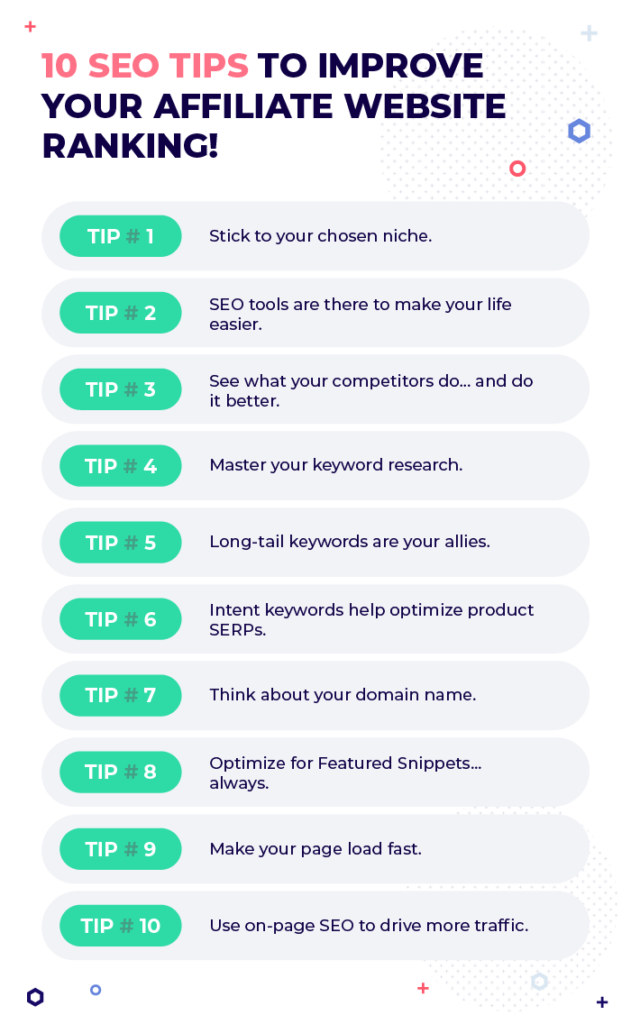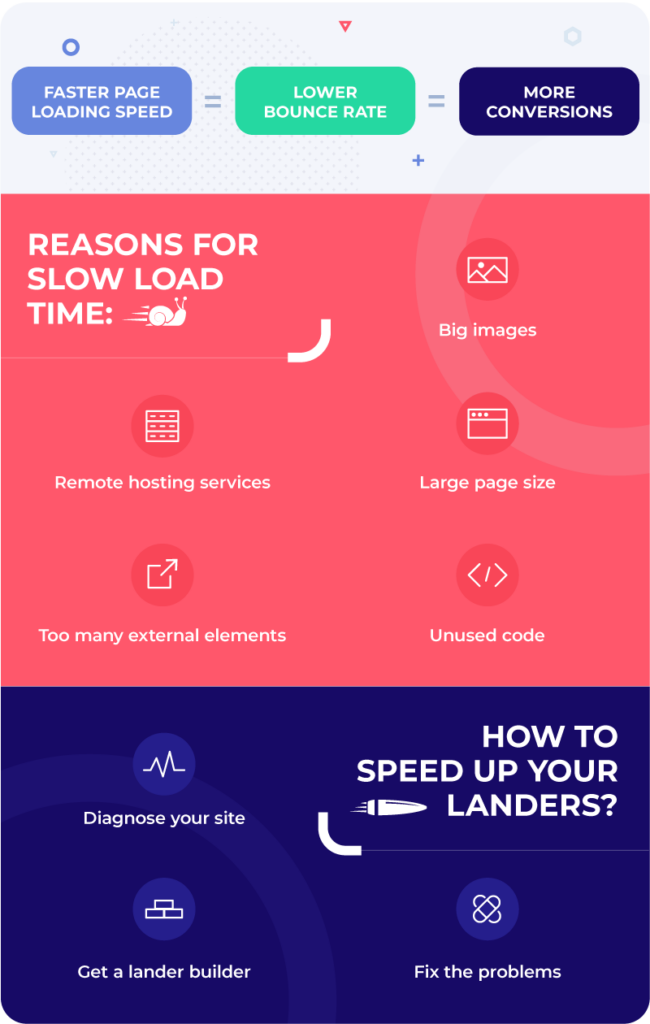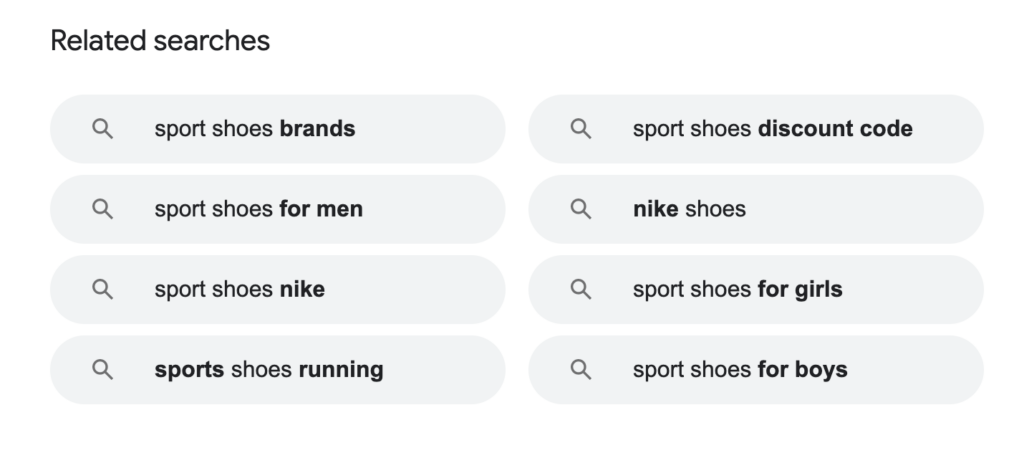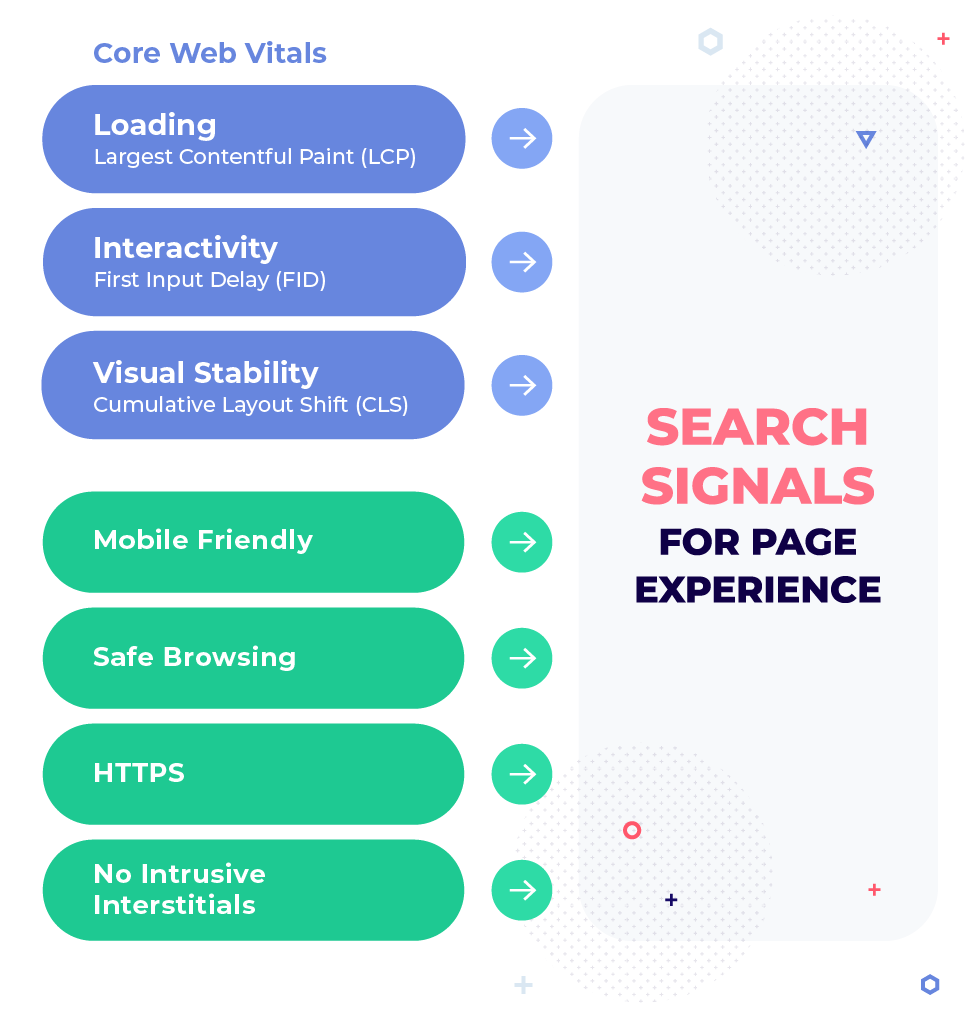SEO affiliate marketing requires you to be an expert in both fields — website SEO and affiliate marketing. That’s quite a skill, but with the number of resources available, an extremely helpful community, and endless opportunities to step up your digital marketing game, it’s well worth it.
That’s why below you’ll find everything you need to know about SEO affiliate marketing, plus the top 10 SEO tips and practices to use in 2022!
What is SEO affiliate marketing?
There are a lot of popular misconceptions circulating the Internet in regards to SEO affiliate marketing. That’s why we feel we need to start this article with some basic myth-busting regarding the two concepts in general.
SEO stands for Search Engine Optimization and refers to various techniques marketers use to improve the quality and quantity of organic traffic driven to a website. SEO means to enhance organic traffic quotas, targeting unpaid traffic, generated mostly by people’s searches and query entries into various searches. That’s why SEO content optimization tends to focus on answering people’s questions and needs they enter into Google, for example.
Affiliate marketing, to put it very simply, is the process of earning commission for promoting other people’s or company’s products. As an affiliate advertiser, you need to find your offer and then help spread the word about it. Whether you do that using organic or paid traffic is entirely up to you.
As you can see, SEO and affiliate marketing are not an either-either type of situation. And they’re definitely not mutually exclusive marketing strategies.
In fact, these two techniques bring the best results when combined.
So, what is SEO affiliate marketing? It’s precisely what the name stands for — it’s using various SEO techniques to improve your affiliate website, or a product landing page rankings. Better positioning means bigger exposure and higher chances for driving organic traffic to your affiliate offer (or offers that you got from an affiliate network ) promoted with a given page.

How does affiliate marketing contribute to SEO performance?
Now that we’ve cleared the basics, it’s time to ask yet another question… or two. Apart from the reasonable question on what the benefits of combining the two strategies are, there’s also the one about mixing paid and free traffic. Let us start with the latter.
Does using SEO techniques to drive free traffic to your website mean you can’t use paid advertising to drive traffic to the same website?
The answer is — no. As we’ve already mentioned, free and paid advertising isn’t mutually exclusive and tends to bring the best results when combined.
Why?
Whether we ask why or how it benefits your website, the answer is simple — it allows marketers to cover a much bigger share of the available market, get bigger exposure, and ultimately drive even more traffic to the desired webpage or offer. Whether that’s your affiliate site or a brand already.
How to rank an affiliate website?
Being one of the top ad networks and traffic sources in the affiliate industry, we at Zeropark tend to have a fairly good understanding of the concept of paid advertising. But today we’re not going to discuss PPC traffic. Today we bring you some of the best SEO affiliate marketing tips and practices to use in 2021 to help you improve your brand, offer, or product landing page rankings, and make the most of your affiliate marketing efforts.
Regardless of whether your advertising strategy is based on organic traffic only, or combining both — paid and free traffic — including the following tips will surely help your campaigns.

Stick to one niche and find the best affiliate products to promote.
Picking the right niche and then sticking to it is even more important for SEO affiliate marketing than it is for paid advertising, alone. That’s because using organic traffic for affiliate marketing campaigns requires time, consistency, and thoughtfully curated content. Some of the best players in the affiliate industry who focus on organic content for promoting their products and offers, like Neil Patel for example, have been creating their platforms for years now.
SEO affiliate marketing is a long-haul game, but combining the two advertising methods can speed up the process significantly. Nevertheless, the better your content marketing strategy and SEO scores, the better your organic traffic quotas. And the more traffic you get to your page, the more traffic you’re able to drive for offers promoted there. Which ultimately results in generating more conversions — of any kind.
That’s why curating a good enough content platform focused on a particular niche is so important. One can’t be an expert at everything — if you try doing so, you might end up with lots of poor quality content that won’t attract any viewership. It’s better to master a particular segment, as this will generate more user-trust and also allow you to get more profitable offers to promote.
Use SEO tools that make your life easier.
Whether you’re an experienced content creator, a budding affiliate marketer, or an SEO-savvy, there’s surely at least a couple of SEO tools that can make your advertising life much easier. We dare say it’d be even a bit foolish not to use any… and count the exact keyword vs. total word count ratio yourself.
These tools, both free and paid, offer some very powerful algorithms that can solve a lot of SEO problems and riddles for us. Depending on your needs, whether that’s precise keyword research, backlink reports, outperforming your competitor’s content, or simply looking for new offer ideas and currently trending products, there’s a tool made just for that.
Some of the most popular SEO tools include Neil Patel’s Ubersuggest, Semrush, Ahrefs, SpyFu, Google Keyword Planner, Google Trends or Answer the Public. If you’d like to learn more about them, click here and read an article discussing a list of SEO tools every smart affiliate marketer should have a look at.
Analyze what your competitors do and do it better.
Now that you know your niche, the products or offers you want to focus on, and what tools can help you up your SEO affiliate marketing game — it’s time to do some spying.
Competitor analysis is a basic step for any kind of business. Only it really couldn’t be easier for affiliate marketers. Whenever you want to check what your competition is promoting at the moment, what keywords they rank for, which works best or worse for them, what kind of content structure they use, and how it performs — it’s all there, served on a silver platter, with various reports available.
Apart from just browsing the Google search and simply reading up on what they have to say and offer, that’s what SEO tools are all about. Just run their URL in one of the tools and see what the analysis says. Do your keywords research and compare it with your competitor’s reports. Finally, improve your content in all the places they fall behind or try to do even better where you see them doing well.
Remember that if you’re able to see all that, they’re able to spy on you too. That’s why staying alert to any changes in your website performance is key to reacting in time when someone you weren’t expecting to have outdone yourself.
Master your keyword research and drive traffic to your affiliate website.
It’s 2022… and if you don’t do your keyword research right, you’re pretty much screwed. Again, with the variety of both free and paid tools meant specifically to aid you with that task, it’d be unwise to rely on a quick Google search alone. Apart from the broad and exact match keywords, advertisers should also optimize for long-tail keywords and intent keywords, too. Then, several other aspects need to be taken into account.
To make it even easier for you, below we listed all the elements that should be included in a thorough keyword research plan. Make sure you try completing every step from the list.
✔︎ KEYWORD RESEARCH TO-DO LIST
- Identify the advertising/product’s niche-related keywords.
- Learn the user intent keywords.
- Research competition keywords.
- List seed keywords.
- Listing long-tail keywords.
- Place keywords in specific places across your content.
- Monitor and score particular keywords performance.
- Monitor your website SERP ranking.
For those who may not be familiar with all the terms in the list above, here’s a handy glossary explaining crucial terms.
|
SEO GLOSSARY SEED KEYWORD: typically short, one or two-word phrases with no modifiers, e.g.: bag. They’re usually the starting point for a more precise keyword listing, leading to creating long-tail keywords. LONG-TAIL KEYWORDS: multiple words phrases that serve as more specific keywords. These can be actual search queries people put into search engines, e.g.: big brown leather bags for women. INTENT KEYWORDS: keywords that reflect the user intent behind a particular search query. Once intent keywords are known, advertisers can target their audience using the most relevant and appealing angle. The most common types of intent keywords are: navigational, informational, transactional, and commercial. SERP a.k.a Search Engine Results Pages: websites displayed by search engines in response to a query searched by users, with top websites displayed as top results. |
Don’t forget long-tail keywords for precise targeting.
If you look at the above glossary you’ll see that we put focus on a few types of keywords. But this tip will help you understand why focusing on long-tail keywords is especially important.
This is because using single-word phrases like “shoes” means we’d be targeting keywords that are just too broad and too general. These tend to show a very high competition score, while their conversion score tends to be extremely low. That’s because people don’t want to buy just any shoes. They want to buy shoes that fit their needs. And that’s why we also need to get more specific with our keywords.
Moving further, two to three-word keyword phrases, like “sports shoes” tend to already give us a better connection with our audience. At least we narrowed it down to sports shoes, excluding quite a chunk of the footwear industry. Still, “sports shoes” is a pretty general term that can be further categorized into men and boys shoes or women and girls shoes to give you the simplest of examples.
That brings us much much closer to meeting the customer needs. Although fairly general, such keyword phrases tend to show medium to high competition rates, with still rather low conversion rates.
But if we really want to get specific selling or promoting affiliate offers related to footwear, there’s still plenty of room for long-tail keyword optimization.
How about “nike running shoes for women” or “outdoor running shoes for boys” or “best selling running shoes for men 2022”. These phrases already give us a lot of information on the potential target audience and allow us to optimize our advertising efforts accordingly.
Long-tail keywords of +4 words tend to bring the best results in terms of low competition rates and high conversion rates.
And your targeting possibilities are just endless.
Optimize product SERPs for intent keywords, too.
Now that we have our keyword targeting sorted, it’s time to optimize them for SERPs and intent keywords, too. Why is it necessary if we already have a fairly precise list of keyword phrases?
That is because using long-term keywords that are also optimized for intent keywords allows you to align with various user SERPs even better than just long-tail phrases could. By using a SERP API, you can gather data on search engine results in pages to determine which intent keywords are most relevant to your products.
Again, remember that intent keywords reflect user intent behind a particular search query. Knowing the type of intent keywords (navigational, informational, transactional, and commercial) and aligning your keyword phrases accordingly basically allows you to recreate almost exact SERPs that people put into Google and other Internet search engines. And helps your content win over any other website that focuses on generic keywords or long-tail keywords only.
The intent keyword example phrases for each intent group are:
- Navigational: sports shoes amazon, women shoes nike,
- Informational: women sports shoes zalando, sports shoes for men, best sports shoes 2022, outdoor sports shoes,
- Transactional: cheap sports shoes for boys, sports shoes deals, women sports shoes sale
- Commercial: buy sport shoes, sport shoes 24h delivery
These allow you to target your advertising angle and message towards your target audience, whether they’re just browsing through, or they’re already at a serious product research phase, whether they look for specific service included or are already purchase oriented.
Think about your domain name.
Choosing proper domain names and paying attention to URL structure can have a tremendous influence on the success of your affiliate website. These are not random items but crucial elements of every site and the user experience it delivers to page visitors. Let’s go through some of them in greater detail.
Well, it’s been long established by Google that simply putting your keywords into domain name does not do the trick. These guys are smarter than that and so are you.
✘ Using brand keywords, unless approved by the brand, may be very harmful to your business. Unless you’re in for a legal battle and getting your content blocked due to using the name of the brand whose products you try to promote, we’d recommend not to do that. Naturally, if you’re the actual brand owner or representative, and are thinking of creating a long-term content strategy for promoting the brand, the legal threat does not apply.
✘ Using broad keywords, which is legal and acceptable, may again be too general. Also, mind the fact such names may already be mostly taken or could be used for domain name reselling purposes. This could be some shady site authority history that again wouldn’t do any good to your business.
✔︎ Using exact keywords, which we stress again doesn’t influence the ranking factor as such, might be the best idea, though. This is because they’d already consist of the general keywords, thus making the website industry quite obvious, yet still adding value in a form of the very direct message as to what your page is/does.
Optimize for Featured Snippets
First, you need to know what types of featured snippets are within the scope of your interest. The available formats are: paragraph, numbered list, bullet list, table, featured video.
Next, remember the following:
- Add your exact keywords into H2 and H3 heading across the page.
- You can try phrasing them as questions or use questions people also ask.
- Research words or phrases that often come up with featured snippets.
- Include a Q&A or FAQ section
- Mind the content structure
Ranking for featured snippets can help you get on top of the SERPs rankings even if your content is slightly different or inferior to top results. That’s why one major tip we’ve got for you is not trying to outrank somebody else’s featured snippets but going for those SERPs that still have none.
Improve your page loading speed
Page loading speed is an extremely important factor that no affiliate or SEO digital marketers can afford to neglect. Some time ago we published a great article on why page loading speed matters and how to speed up your website to enhance its performance. In this article, we answer some of the most common questions regarding page speed. Just have a look below!
Page loading speed FAQ
- How loading time affects the performance of your website?
- What is a good website loading speed?
- What tools are best for checking how fast a website loads?
- How to speed up your website’s loading time?
- What are common page speed optimization DOs & DON’Ts?
As this is a rather technical topic that needs a thorough explanation, we invite you to click here and find out all you need to know about page loading speed optimization.

Get more website traffic with on-page SEO
This is the last step described in this article, but it can also be treated as a summary of everything we’ve just discussed. But what is on-page SEO exactly?
According to HubSpot’s article The Ultimate Guide to On-Page SEO in 2022:
“On-page SEO, or on-site SEO, is the process of optimizing various front-end and back-end components of your website so that it ranks in search engines and brings in new traffic. On-page SEO components include content elements, site architecture elements, and HTML elements.”
Don’t get discouraged by the technical elements though, as these can be easily optimized… on-page. This term refers to all the elements and techniques of structuring, testing, and then adjust your content for the best performance. The below checklist can help you with that:
On-Page Affiliate SEO Checklist:
- Create real value and high-quality content for your users.
- Optimize page titles for both user intent keywords and long-tail keywords.
- Use H1, H2, H3 heading structure throughout your content.
- Don’t forget to optimize your meta descriptions with user intent and exact keywords.
- Do add image alt-texts!
- Consider UI/UX flow while structuring your website.
- Optimize page URLs to march the keyword research and user journey plan.
- Work on both internal and external linking for higher CTRs.
- Optimize for mobile.
- Improve your page loading speed.
And voila! Sticking to the top 10 SEO tips and practices we’ve collected here will surely help you take care of your website concisely and thoroughly. But since the digital world is an ever-changing landscape, there are and will always be new things to learn and account for during your affiliate website SEO optimization process.
And the dreaded and coming oh so soon Google Core Web Vital update is one of them.
How to prepare for Google Core Web Vitals update?
Again, let us start by busting a myth regarding the latest hype around the Google Core Web Vitals update. No, Core Web Vitals are nothing new. Core Web Vital elements have been a part of the ranking system for some time already, only the update that was announced to take place in May 2021 will give them higher priority over other ranking factors.
Why? Let’s have a look at what Google Core Web Vitals are in fact.
The three metrics stand for page loading speed, page interactivity, and visual stability — as translated from rather technical-sounding names visible on the graphic. Nothing new, see? Only this time these three elements take way above other ranking factors such as mobile optimization or browsing security. That’s why to prepare for the upcoming update what you should do to make sure your page is CWV-optimized is the following.
Google Core Web Vitlas To-Do List:
- Start by checking your Core Web Vitals metric scores in the Google Search Console.
- Focus on the areas showing the worst performance first, then work your way up to what’s also urgent but shows decent results. Mind the process may not be that quick.
- Check whether your web hosting services can keep up with the update requirements, if not you need to upgrade.
- Work on optimizing your images and video content size.
- Focus on the content above the fold for better user retention.
- Remember that page experience doesn’t override content — it still matters a great deal.
- Up your mobile game. A lot.
- Make sure to use all the available Google page optimization tools, as well as other options the industry provides.
- Stay on the lookout for the latest update information and tips from SEO experts. There’s a lot of details that could truly help your CWV scores.
- Monitor your page performance carefully before, right around and after the update release to spot any issues and react quickly and efficiently.
Conclusions
Whether you’re an affiliate advertiser who’s been doing PPC campaigns for years now, or an affiliate who’s only started to grow their business through a blog or content platform, your common goal is to make profits by promoting other people’s products and services. That’s the essence of affiliate marketing after all.
One tip we can give you right away is that knowing the industry specifics, even the ones that are not your general line of business, will always help you get some fresh ideas.
And as we said before, we’re not an SEO-oriented platform, there are people who are much better at this than us. What we’re good at, though, is the affiliate marketing side of the coin. So if you’ve got any more questions about that, you know who to ask.
Start Your Affiliate Marketing Journey Now
Run Ads With Zeropark
Kinga Gawron




